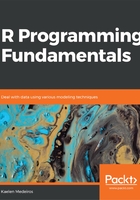
上QQ阅读APP看书,第一时间看更新
Matrices
A matrix is a 2D vector with rows and columns. In R, one requirement for matrices is that every data element stored inside it be of the same type (all character, all numeric, and so on). This allows you to perform arithmetic operations with matrices, if, for example, you have two that are both numeric.
Let's use matrix() to create a matrix, examine its class, use rownames() and colnames() to set row and column names, and access different elements of the matrix using multiple methods. Follow the steps given below:
- Use matrix() to create matrix1, a 3 x 3 matrix containing the numbers 1:12 by column, using the following code:
matrix1 <- matrix(c(1:12), nrow = 3, ncol = 3, byrow = FALSE)
- Create matrix2 similarly, also 3 x 3, and fill it with 1:12 by row, using the following code:
matrix2 <- matrix(c(1:12), nrow = 3, ncol = 3, byrow = TRUE)
- Set the row and column names of matrix1 with the following:
rownames(matrix1) <- c("one", "two", "three")
colnames(matrix1) <- c("one", "two", "three")
- Find the elements at the following positions in matrix1 using matrix indexing:
matrix1[1, 2]
matrix1["one",]
matrix1[,"one"]
matrix1["one","one"]
The output of the code is as follows:
